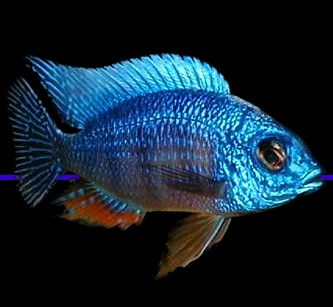African Cichlids: First and foremost, African cichlids are prized and
adored for their beautiful coloration. they
are very hardy fish, which makes them easy
to maintain. Their care is not so easy, however, that it would bore the
advanced, but because they’re hardy they don’t present an impossible
challenge for the beginner. The fact that they are freshwater fish
simplifies things a whole lot, but what makes their maintenance even
easier is that they need hard, alkaline water. Yet another reason for African cichlids’
popularity is due to their unique and remarkable behavior. In general,
they are very social, displaying lots of energetic movement anytime
someone walks past the tank. They will race in a swarm along the glass,
always appearing starved. African
cichlids are also very aggressive fish.
For the beginner this may be daunting, but if enough about their
behavior and needs is understood, this attribute can be turned to the
advantage of the aquarist. One of the advantages this aggression has is
that African cichlids can be “crowded.” When kept in a crowded
environment, aggressive and dominant fish tend to lose their victims in
the crowd. Crowding is actually a condition that is found in the wild,
as they are often found in densities as high as 10-18 fish per square
meter. African Cichlids come from Lakes Malawi, Victoria, and
Tanganyika in Africa.
South
American Cichlids: South American Cichlids are a diverse
group of fish often referred to
as New World Cichlids. Cichlids are hardy, easy to care for fish that
add brilliant color to the freshwater aquarium. South American Cichlids
are found from Central America through South America and can be
categorized into Dwarf Cichlids, Larger Amazonian Cichlids, and Larger
Neotropical Cichlids, all of which have different care levels and tank
requirements. These larger species are mostly predatory fish that are
territorial in
nature and should be maintained in the semi-aggressive or aggressive
aquarium. South American Cichlids have very interesting personalities
and are extremely intelligent fish with highly evolved parental skills,
making them one of the most popular groups of aquarium fish.
Goldfish: The goldfish is usually classified as a coldwater
fish, and it can live in an unheated aquarium. Build-up of this waste
to toxic
levels can occur in a relatively short period of time, which is often
the cause of a fish's sudden death. It may be the amount of water
surface area,
not the water volume, that decides how many goldfish may live in a
container, because this determines how much oxygen diffuses and
dissolves from the air into the water; one square foot of water surface
area for every inch of goldfish length. If the water is
being further aerated by way of water pump, filter or fountain, more
goldfish may be kept in the container. Goldfish may be coldwater fish,
but this does not mean they can
tolerate rapid changes in temperature. The sudden shift in temperature
that comes at night, for example in an office building where a goldfish
might be kept in a small office tank, could kill them, especially in
winter. Temperatures under about 10 °C (50 °F) are dangerous to
goldfish. Conversely, temperatures over 25 °C (77 °F) can be
extremely
damaging for goldfish (this is the main reason why they shouldn't be
kept in tropical tanks).
Community
Fish: A Community Aquarium is a fish tank that contains
a diverse group of fish,
rather than just one type. Although there is no question that a tank
full of
the same species of fish, such as Guppies or Neon Tetras, can be very
attractive, it still is far more interesting to have an aquarium that
houses
several species of tropical fish at once.
Some of the best
fish for a Community Aquarium are:
- Tetras (any kind)
- Barbs (any
kind)
African
Cichlids
- Danios (any kind except the Giant
Danio)
South American Cichlids
- Gouramis (any
kind) Community Fish
- Guppies (any
kind)
- Swordtails (any kind)
- Platies (any
kind)
- Angelfish (except for those really big
ones!)
 Click on the image for more information on African Cichlids
Click on the image for more information on African Cichlids
- Mollies (any
kind)
- Corydoras (any kind)
- Algae Eater (any kind)
Top of Page
 Click on the image for more information on African Cichlids
Click on the image for more information on African Cichlids  Click on the image for more information on African Cichlids
Click on the image for more information on African Cichlids